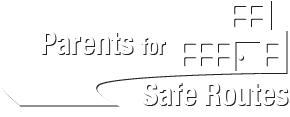Possible solutions for Coleman Avenue
It is first important to know that Coleman Avenue in Menlo Park is multi-jurisdictional. The stretch of Coleman from Willow Road to right after the apartments end (between Riordan and Berkeley) is under the jurisdiction of the City of Menlo Park. The stretch from there to Ringwood (in Menlo Oaks) is part of Unincorporated San Mateo County.
Here are the main options for Coleman (obviously all of these options carry a ripple affect to other streets/neighborhoods):
1. Accept that Coleman is and will be dangerous and/or stressful for pedestrians, bicyclists and cars.
If this option is selected then Coleman should NOT be designated as a Safe Route for kids traveling to/from M-A, Laurel and other schools. It's offensive to tell kids and parents to share the narrow dirt (in the County portion) shoulder/or to share the road with SUV's, garbage trucks, etc. If this option is selected, then the community should invest in more school buses or accept that more parents will drive their kids to school (and yes, regardless of the option, parents should carpool if possible). With this option, the best we can do is look at traffic calming measures to slow the volume of cars (since it won't change). This means possibly add stop signs (needs enforcement), crosswalks, digital speed signs, speed bumps, and other measures like that. While this may cause cars to linger longr on Coleman, at least the speed will be lower (hopefully won't lead to road rage and aggressive driving).
2. Make Coleman a Safe Route by installing sufficient biking and walking infrastructure (bike lanes and sidewalks throughout).
This option would require parking removal along the City stretch (at least during school commute hours - note that parking is already restricted along the County stretch thanks to the Menlo Oaks residents of Coleman). A check would be needed to see if Coleman is wide enough in the City stretch between Willow and Santa Monica to retain parking on at least one side during peak hours ( many apartment dwellers, Roberts Pre-School parents, etc. depend on street parking...). If bicyclists and pedestrians were separated from cars along the entirety of Coleman (both City and County) it would have a major positive impact. Many parents would love their child to be able to bike along Coleman (either with their supervision or on their own in the case of older kids) but don't allow it because it's not safe as is. Nationally, 10-14% of morning commute congestion is attributable to school traffic - likely higher on Coleman. If we can get kids and families out of their cars and onto their feet and bikes, it can make Coleman less congested. Also, by adding bike lanes, we will be narrowing the road. When roads get narrowed, cars tend to drive more carefully.
3. Make Coleman a Safe Route by greatly limiting the traffic flow on the street. This can be done in two ways.
The first way is through turn restrictions. This could be done by preventing turns from Willow Road onto Coleman in the morning and turns onto Coleman from Ringwood in the afternoon. Other streets (like Gilbert, Nash, etc. - on the Willow side and Arlington, Colby, etc. on the Ringwood side) would also need turn restrictions so they don't get the brunt of the traffic redirection. The goal would be to keep traffic on better equipped arteries such as Bay Road (though those neighbors may not take issue with this) and Middlefield. You could also restrict left turns at Santa Monica and Riordan onto Coleman. This will force parents from the Willows and Vintage Oaks/South of Seminary to either bike/walk (or take the bus) or to drive on Middlefield. Lots of degrees on how far to take this.
The second, and more extreme way of significantly reducing volume would be to close down Coleman Avenue at the County Line (between Riordan and Berkeley). You could either do this completely, or make it a one way street (if pursued, it makes more sense having it travel North, towards M-A/Laurel). By closing it completely or making it one way, you definitely have room for safe walking and biking and you could probably do so with just painted lines and not new sidewalks. Clearly, this last option would drastically alter the traffic patterns in Menlo Oaks and around this area. Turn restrictions on neighborhood streets would also likely be needed. Neighbors would probably have a harder time reaching their homes/schools and it would add minutes to many folks' commutes. However, thinking about "who and what are we designing our streets for? and what trade-offs are we willing to live with?”...perhaps some of these inconveniences would be worth it if when we got home our streets were safe and neighborly.
Parents for Safe Routes will not be the one ultimately determining which, if any, of the following options will be pursued, let alone implemented. Neighbors need to start thinking creatively and beyond the status quo and to begin considering options that may improve the safety of our kids and the quality of lives.
A study from 2007 (10 years ago!) examined many of the above options. You can check out the materials here. Please note that due to lack of consensus, no action was ever taken on Coleman.
Illustration of alternatives:
Safe Routes to Laurel Elementary School (2007)
Staff Reports detailing the history and reasoning:
Staff Report #07-185 (November 6, 2007)
Staff Report #07-197 (November 16, 2007)
